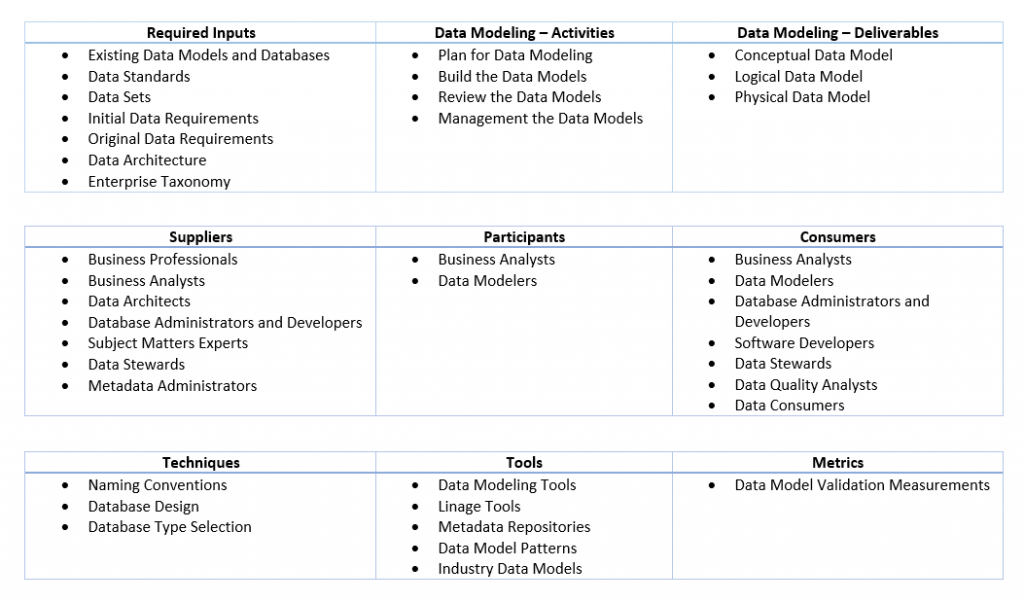What is Data Modeling?
Data Modeling is the process of creating an illustrative and visual representation of either a whole information/database system or parts of it to show the relationships among data types, the ways the data can be grouped, organized, its formats, and attributes. Data models are built around business needs. Rules and requirements are defined upfront through feedback from business stakeholders so they can be incorporated into the design of a new system or adapted in the iteration of an existing one.
Importance of Metadata in Data Modeling
Data models comprise and contain Metadata essential to data consumers. Much of this Metadata uncovered during the data modeling process is essential to other data management functions. For example, definitions for data governance and lineage for data warehousing and analytics.
Benefits of Data Modeling
Data Modeling makes it easier for developers, data architects, business analysts, and other stakeholders to view and understand relationships among the data in a database or data warehouse. Additionally, it can also:
- Reduce errors in software and database development.
- Increase consistency in documentation and system design across the enterprise.
- Improve application and database performance.
- Ease data mapping throughout the organization.
- Improve communication between developers and business intelligence teams.
- Ease and speed the process of database design at the conceptual, logical, and physical levels.
Role of Data Models in Data Management
Data Models are critical to effective Data Management, as they:
- Provide a Common Vocabulary around Data
- Capture and Document Explicit Knowledge about an Organization’s Data and Systems
- Serve as a Primary Communications Tool during Projects
- Provide the Starting Point for Customization, Integration, or even Replacement of an Application
Long-Term Value of Data Modeling
Data modeling creates a foundation for completing broad-scoped initiatives such as Master Data Management and Data Governance Programs. Proper Data Modeling leads to lower support costs and increases the re-usability opportunities for future initiatives, thereby reducing the costs of building new applications. Data Models are an important form of Metadata.
Data Models Categories
Three-Schema Approach
Three-Schema Approach to Database Management, i.e., Conceptual, External, and Internal. These three levels most commonly translate into the Conceptual, Logical, and Physical Levels of Detail, respectively.
Types of Data Models
Conceptual Data Model (CDM)
The Data Modeling process starts with the Conceptual Data Model, progresses to the Logical Data Model, and concludes with a Physical Data Model. This model, also referred to as the Domain Model, offers a big-picture view of what the system will contain, how it will be organized, and which business rules are involved. Conceptual models are usually created as part of the process of gathering initial project requirements.
Logical Data Model (LDM)
This is comparatively less abstract and provides greater detail about the concepts and relationships in the domain under consideration. One of several formal data modeling notation systems is followed. These indicate data attributes, such as data types and their corresponding lengths, and show the relationships among entities. Logical data models don’t specify any technical system requirements.
Physical Data Model (PDM)
This model provides a schema for how the data will be physically stored within a database. As such, these types of models are the least abstract of all. They offer a finalized design that can be implemented as a relational database, including associative tables that illustrate the relationships among entities as well as the primary keys and foreign keys that will be used to maintain those relationships. Physical data models can include database management system (DBMS)-specific properties, including performance tuning.
Data Modeling Types
- Hierarchical Data Models represent one-to-many relationships in a tree-like format. In this type of model, each record has a single root or parent that maps to one or more child tables.
- Entity-Relationship (ER) Data Models use formal diagrams to represent the relationships between entities in a database.
- Dimensional Models: While relational and ER models emphasize efficient storage, dimensional models increase redundancy in order to make it easier to locate information for reporting and retrieval. This modeling is typically used across OLAP systems. Two popular dimensional data models are the star schema, in which data is organized into facts (measurable items) and dimensions (reference information), where each fact is surrounded by its associated dimensions in a star-like pattern.
Popular Data Modeling Tools
- ERWIN Data Modeler
- Enterprise Architect
- ER/Studio


